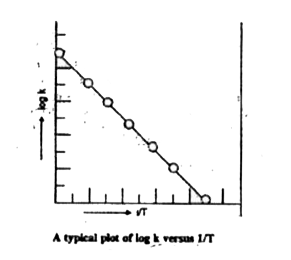What is Arrhenius equation to describe the effect of temperature on rate of a reaction ? How can it be used to calculate the activation energy of a reaction ?Solution in Punjabi
Arrhenius (1889) developed a mathematical relationship between temperature and the rate constant on the basis of the observations from the large number of experiments. The temperature dependence of the rate constant, k is expressed algebraically as follows.
k∝e−Ea/RT
k=Ae−Ea/RT

This equation is known as Arrhenius equation. Here, A is a constant of proportionality and is known as frequency factor:-This-factor is related to the number of binary molecular collisions per second per litre. E is the activation energy, R is gas constant and T is the absolute temperature. Taking logarithm, egn. (1) may be written as ,
In k=In A+ In e−Ea/RT
In k=In A-EaRTIne
In k=InA−EaRT [∵In e=1] ...(ii)
Converting to common logarithm, we get
logk=logA−Ea2.303R1T ... (iii)
or logk=−Ea2.303R1T+logA
This equation is of the form y = mx + ci.e., the equation of a straight line. Thus, if a plot of log k versús 1/T is a straight line, the valdity of the equation is confirmed. From eqn: (lin) we havė,
Slope of the line = Ea2.303R
Thus, by knowing the value of the slope and gas constant R, the activation energy E can be calculated.
Alternatively, Ea, can be determined by using another form of the Arrhenius equation in which A is eliminated. This is because frequency factor A cannot be determined accurately for the reactions. From eqn. (iii)
In k=In A-EaRT
In k = In k1 and k2 are the values of rate constants at temperatures T1 and T2, then,
In k1=InA−EaRT1 ...(iv)
and Ink2=InA−EaRT2
In Subtracting eqn. (iv) from egn. (v), we get
In k2-In k1=−EaRT2−−EaRT1
In k2−Ink1=EaRT1−EaRT2
In k2k1=Ea2.303R[T2−T1T1T2]
Converting to common iogarithm,
log k2k1=Ea2.303R[T2−T1T1T2]
Topper's Solved these Questions
- CHEMICAL KINETICSBOOK - BETTER CHOICE PUBLICATIONCHAPTER - CHEMICAL KINETICSEXERCISE - Numerical Problems
63 Videos
- BIOMOLECULES BOOK - BETTER CHOICE PUBLICATIONCHAPTER - BIOMOLECULES EXERCISE - QUESTION BANK
85 Videos
- CHEMISTRY IN EVERYDAY LIFEBOOK - BETTER CHOICE PUBLICATIONCHAPTER - CHEMISTRY IN EVERYDAY LIFEEXERCISE - QUESTIONS
76 Videos
Similar Questions
The rate constant of a reaction is 1.5×107sec−1 at 50∘C and 4.5×107sec−1 at 100∘C. Calculate energy of the activation for the reaction.
View SolutionCovalent compounds are soluble in
View SolutionWhat is a medicine ?
View SolutionThe temperature dependence of rate constant (k) of a chemical reaction is written in terms of Arrhenius equation, k=Ae−Ea/RT) Activation energy (Ea) of the reaction can be calculate by plotting
View SolutionTh Arrhenius equation expressing the effect of temperature on the rate constant of the reaction is
View SolutionThe Arrhenius equation expressing the effect of temperature on the rate constant of a reaction is
View SolutionThe temperature dependence of rate constant (k) of a chemical reaction is written in terms of Arrhenius equation, k=Ae−Ea/RT) Activation energy (Ea) of the reaction can be calculate by plotting
View SolutionWhat is Arrhenius equation ? Derive an equation which describes the effect of rise of temperature (T) on the rate constant (k) of a reaction.
View SolutionAssuming that energy of activation for most of the reactions is 52 kJ, what conclusion you draw about the effect of temperature on the rate of a reaction ? (Based on Arrhenius equation)
View SolutionArrhenius studied the effect of temperature on the rate of a reaction and postulated that rate constant varies with temperature exponentially as k=Ae^(-E_(a)//RT) . For most of the reactions, it was found that the temperature coefficient of the reaction lies between 2 to 3. The method is generally used for finding the activation energy of a reaction. Keeping temperature constant, the effect of catalyst on the activation energy has also been studied by studying how much the rate of reaction changes in the presence of catalyst. In most of the cases, it is observed that catalyst lowers the activation energy barrier and increases the rate of reaction. If the rate of reaction doubles for 10^(@) rise of temperature from 290 K to 300 K, the activation energy of the reaction will be approximately
View SolutionWhat would the effect of temperature be on the rate constant of a reaction with zero activation energy ?
View SolutionThe temperature dependence of rate constant (k) of a chemical reaction is written in terms of Arrhenius equation, k=Ae−Ea/RT) Activation energy (Ea) of the reaction can be calculate by plotting
View SolutionTh Arrhenius equation expressing the effect of temperature on the rate constant of the reaction is
View SolutionThe Arrhenius equation expressing the effect of temperature on the rate constant of reaction is
View SolutionExplain the rate of reaction with energy of activation and temperature with the help of Arrhenius equation state its importance .
View SolutionThe Arrhenius equation expressing the effect of temperature on the rate constant of a reaction is given as
View Solution
